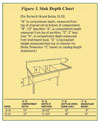
When specifying a commercial kitchen sink, there are several important factors that engineers should take into consideration, such as material type, gauge, shape, depth, sound suppression and surface finish. Navigating through the wide array of stainless steel commercial sink options can be simplified if engineers know what factors comprise a highly functional, quality, durable sink. The following tips can be used as a helpful guide for engineers specifying stainless steel sinks for commercial applications.
Stainless Steel: Superior for Sinks
Stainless steel is a superior material for commercial applications because it does not crack, chip or discolor when compared to other materials, such as enameled cast iron and vitreous china. Stainless steel is easy to clean and sanitize, and many high-quality stainless steel commercial sinks are certified for food preparation by NSF International (an independent third-party developer of standards, product testing and certification services in the areas of public health, safety and protection of the environment). Stainless steel’s ease of cleanability is just one reason it is specified across multiple commercial applications, including schools, institutions, hospitals, factories and restaurants.
Stainless steel offers a higher resistance to rust and corrosion than standard carbon steels, but it is important to select the correct type and grade of stainless steel for the particular application. This is important because the steel type principally dictates the sink’s chemical resistance through its chromium, molybdenum and nitrogen content.
Stainless steels contain at least 10.5 wt-percent chromium, which gives them the ability to form a thin and adherent passive oxide layer when exposed to air, while the molybdenum and nitrogen improve the strength of the film. For example, Type 304, with 18 wt-percent chromium, is the most common choice, but Type 316, with 16% chromium and 2% molybdenum, is more resistant to many concentrated chemicals. Type 316 steel is frequently used in the manufacturing and handling of food as it holds up well against many of the chemicals used in cleaning and sanitizing procedures. Type 316 also is known as “marine grade” stainless steel due to its increased resistance to chloride-pitting corrosion compared to Type 304 (seeFigure 1).

Figure 1
Gauging the Gauge
When specifying stainless steel commercial products, one important factor is the gauge, or thickness, of the material. As many engineers understand, the lower the gauge number, the thicker the steel and the sturdier the sink (see Figure 2). Since commercial sinks are installed in high-traffic areas, they are typically manufactured in 14-gauge or 16-gauge. Residential sinks, which are often made from slightly thinner steel, usually range from 18-gauge to 22-gauge. When determining what products are best to specify for a functioning commercial kitchen, engineers need to make sure the stainless steel sink manufacturer is providing them with a durable product constructed of the appropriate thickness of stainless steel that will match the design life or life-cycle for the application.Size and Depth
Another important feature to consider is the appropriate size and depth of the sink, since it comes in such a wide variety (reference Figure 3 on page 38 for a depth chart). First, the primary use of the sink needs to be determined. For example, will it be used as a wash station for multiple people, or will the sink need to handle a large quantity of dishes?
After the primary use is decided, a choice can be made between a single-, double- or triple-bowl sink. The most common shapes for commercial sinks are square and rectangular, which should also be chosen based on the functionality of the sink. While it is important to choose a bowl that is both deep and wide enough to hold a multitude of different-sized containers, pots or pans, engineers should remember that deeper is not always better. A sink that is too deep for its primary application requires more bending than necessary and can cause lower back problems for users.
Suppressing Sound
One feature that is generally overlooked when specifying commercial sinks is sound-deadening insulation. Sinks are available with different bottom insulation options that help to reduce noise during use. While it’s not always necessary, sound deadening can make a significant difference in some applications. When sound-damping insulation is specified, a commercial sink will be fitted with comprehensive undercoating and sound-absorbing pads to prevent noisy clanging and assure a more relaxed experience for the venue’s clientele. Sound deadening is especially important in open kitchen restaurants, as it makes for a more productive work place for the staff and a more enjoyable experience for diners.

Figure 2
The Finishing Touch
The surface finish also is an essential factor, as it affects the unit’s appearance, which is especially important for a high-traffic commercial sink. When the exterior of the sink becomes part of the visual landscape, such as an exposed kitchen or high-end establishment, it is wise to choose a surface finish that is hand-blended to a uniform lustrous satin finish.A satin finish not only hides weld, burn and grind marks from the manufacturing process, it also provides superior protection from scratches during use and blends them together for a clean, smooth look. If the appearance of the sink is not an issue, a prefinished surface also is an option. A prefinished surface will not conceal scratches like a satin finish.
Further Features
In addition to specifying a sink that has superior surface, sound, strength, shape and size, specifiers should keep in mind features such as ease of installation, any backsplash needs and what type of corner and rim design are required for the application. In terms of installation, engineers should check that the manufacturer can provide full support legs or wall hanger and support brackets, depending on the type of commercial sink installation.
When choosing what type of sink corners or rim to recommend, it’s important to associate the corner radius and rim design with the sink’s functionality. For example, a slight radius corner may be easier to clean, whereas a zero-radius corner can provide added capacity for cleaning larger items. Engineers will want to use manufacturers who can provide the depth and breadth of product offering needed to support all types of commercial specifying needs.
Commercial Faucets
In specifying the sink, the engineer also will need to consider the type of commercial faucet that will be utilized. The faucet mounting holes are generally pre-determined and punched out at the sink supplier. The ability to punch these holes out at the jobsite is very difficult and should be avoided at all cost. In general, faucets will be mounted in one of the following configurations for commercial kitchen sinks:
· Wall mounted in 4- or 8-inch centers;
· Exposed deck with 8-inch centers;
· Concealed deck with single hole or 8-inch centers.
Once the faucet mounting configuration is established, the engineer also will need to specify the appropriate commercial faucet style. A wide variety of designs are available from an assortment of suppliers. Some sink suppliers also will have a line of faucets that are designed to incorporate with their sinks and may come in a bundled offering, which can reduce some of the details involved in developing the project specifications.

Figure 3
Custom Designs
Some manufacturers offer custom-made designs that meet every unique commercial and institutional requirement. These sinks are made to order for the ideal height, width, length and flexibility for specific applications that standard catalog items simply will not satisfy. A customized sink option is ideal for engineers working with a distinctive kitchen style or a space that has a unique layout.ADA Compliancy
Engineers also should take into consideration ADA requirements when specifying commercial sinks. Most manufacturers offer ADA-compliant products that not only make life easier for people with disabilities, but also allow restaurants and other facilities to meet the requirements of federal law. These sinks are designed to comply with the specific federal guidelines, such as the height, depth and location of sinks and faucets.